
* During World War II, the various combatants experimented with a number of guided munitions, focusing on glide torpedoes and glide bombs. Although they saw little use, they pointed the way to better "smart munitions" in the postwar period. This document provides a history and description of the smart weapons of the Second World War. A list of illustration credits is included at the end.
* The Germans experimented with glide weapons as far back as the First World War, in the form of "glide torpedoes" designed for the Imperial German Navy by Siemens-Schukert Werke (SSW). These were very ingenious weapons, featuring a "wire guidance" system that allowed an operator to control their flight via wires trailing behind them, and an airframe that split open to release the torpedo. Both biplane and monoplane glide torpedoes were developed, with weights of up to a tonne. While some test drops were performed from Zeppelins and captive tests were performed with bombers, these weapons were not used in combat during the war.
Glide torpedoes were developed for the Third Reich in the late 1930s by the Blohm und Voss company. The sketchy information available indicates that they were unguided after launch, and saw little or no combat.
Blohm und Voss also experimented with a "glide torpedo" that was actually a very primitive attempt to build the equivalent of a modern "sea skimmer" anti-ship missile. This weapon, designated the "BV 143", was designed to glide down to wavetop height, where it would use a mechanical "feeler" arm about two meters long to gauge its altitude over the waves. On contact with the waves, the feeler arm would fire the weapon's liquid fuel rocket engine to keep the weapon at altitude until it struck the target ship above the waterline. BV 143 prototypes were launched four times, and to no surprise all of them went into the water. Sea skimmers would have to wait for better technology.
In addition, Blohm und Voss developed a true glide bomb named "Hagelkorn (Hailstone)", designed by Dr. Richard Vogt. This was a streamlined bomb with a cruciform tail and long slender wings, with the wings made of steel cores supporting an airfoil of form-cast concrete, presumably with some sort of reinforcement to keep it from cracking under flexure. This unusual construction was apparently intended to help separation of the weapon from the carrier aircraft. When the Hagelkorn was attached to the carrier aircraft's stores rack or pylon, stubs were fitted between the aircraft and the tips of the Hagelkorn's long stiff wings to cause a slight bend. The spring tension provided by the concrete-stiffened wings ensured clean separation.
The initial version of the Hagelkorn was the "BV 226", which had a spindle-shaped body 3.53 meters (11 feet 7 inches) long, with long slender wings spanning 6.4 meters (21 feet), and a cruciform tail. The front half of the body contained a warhead, while the rear half contained the guidance system. The long wings gave the Hagelkorn a glide ratio of 25:1, meaning it flew 25 meters for every meter it dropped, and so had potentially long standoff range. The BV 226 quickly led to the "BV 246", which was similar, but had a twin-tailfin configuration.
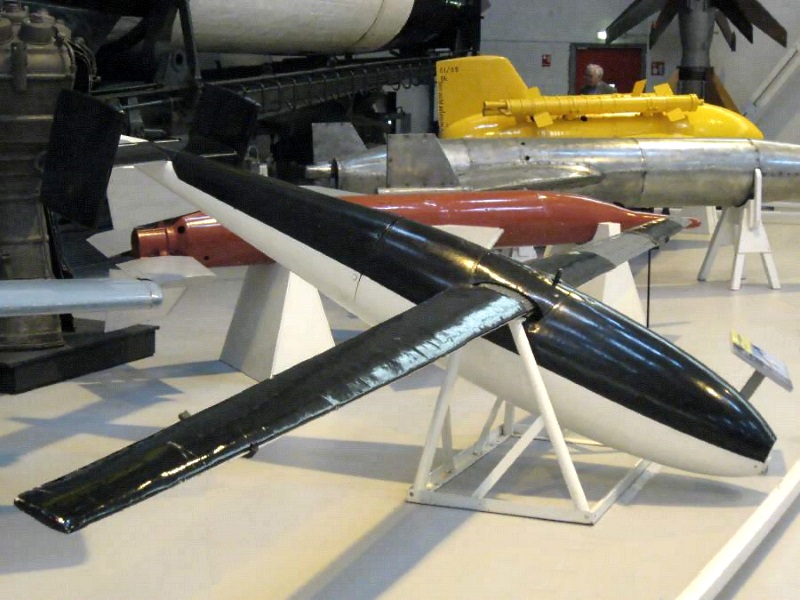
The Hagelkorn had a gyroscopic stabilization system, and it appears that at least at first that was its only guidance scheme. The weapon was simply released to glide off in the direction of the target. That was obviously not very accurate, particularly for a long-range weapon, and the Germans worked hard to develop a reliable, accurate, and jam-resistant means of providing precision guidance for the Hagelkorn, particularly against targets outside of visual range.
Designing a guided weapon that could deal with countermeasures was difficult, particularly because the British were very clever at electronically outfoxing the Germans -- so much so, that some Germans refused to believe the British could be so many steps ahead of them. Experiments were performed with infrared heat-seeker and radio guidance schemes, but the Luftwaffe, the German air force, was not enthusiastic about the Hagelkorn, and though over 1,100 of the weapons were built starting in late 1943, the project was canceled in early 1944. Test drops of the weapon were performed by Heinkel He 111 bombers and Focke-Wulf Fw 190 fighters, but the Hagelkorn saw little or no combat action.
The BV 246 was revived a year later in small-scale tests where it was fitted with a passive radar seeker, or "Radieschen", to home in on emissions from Allied radar stations. Ten of these weapons were tested, and though two proved extremely accurate, the other eight failed. There was no time left for the Reich to field such a weapon in any case.
BACK_TO_TOP* The Germans were much more enthusiastic about the development of two other guided munitions, the Henschel "Hs 293A" and Ruhrstahl "Fritz X" glide bombs. The motivation for developing these guided weapons was attacks on naval vessels. Hitting a moving target like a ship from an aircraft is obviously much more difficult than hitting a fixed target on the ground. Of course, scoring a hit becomes easier the closer an aircraft gets to the ship, but as the saying goes: "If the enemy is in range, so are you." The closer an aircraft got to a ship, the better a target it became for ship's antiaircraft (AA) guns.
This problem was aggravated if the target was, for example, a heavily armored battleship. A conventional bomber had to attack such a monster from the air with armor-piercing bombs dropped from high altitude to give them the kinetic energy needed to punch through the target's armor before exploding, but that made hitting the target difficult.
The alternate approach was the dive bomber, in which a pilot flew his aircraft flew directly down at the target at a steep angle, building up speed and ensuring accuracy through the simple measure of aiming his entire aircraft at the target, and releasing the bomb at low altitude. This put the dive bomber into the teeth of AA guns, and such aircraft also had to stand the stresses of screaming dives and the resulting high-gee pull-outs. That meant they could not be very big, and so in general could not have the long range needed for an ocean-patrol aircraft. Naval dive bombers were carrier aircraft, and the Germans never had an operational aircraft carrier.
Torpedo bombers had similar limitations. Dropping a torpedo from an aircraft was a somewhat tricky business, and it was difficult for an aircraft to carry a torpedo big enough to sink a large vessel with a few hits. Torpedo bombers were also vulnerable to AA fire while they made their torpedo drops. The skip bombing tactics used by the Americans in the South Pacific suffered some of the same drawbacks.
While dive, torpedo, and skip bombing were all used effectively by other nations, the Germans decided to pursue another option for anti-ship attack, one that would win out, decades later: guided weapons. Electronic guidance would allow the launch aircraft to release the weapon out of range of target defenses, and then direct it to a pinpoint strike on the target.
* A team at Henschel under Dr. Herbert Wagner began work on the Hs 293 in July 1940. Wagner and his team built a number of "Hs 293 V1" prototypes. These were unpowered glide bombs. They were tested successfully, and followed by a number of similar "Hs 293V-2" and "Hs 293 V3" prototypes, with minor refinements. However, the tests proved that an unpowered glide bomb tended to fall behind the launch aircraft, making it difficult to guide, and so the next version, the "Hs 293A-0", had a pod strapped underneath its body containing a Walter 109-507B liquid-fuel rocket motor. Results were very satisfactory, and with a few further changes, the weapon went into production as the "Hs 293A-1".
The Hs 293A-1 was a radio-guided glide bomb with light alloy wings spanning three meters (ten feet) and tail surfaces of similar construction. While early units used conventional elevators and ailerons for control, production weapons used spoilers. There was no rudder; the bomb turned by banking.
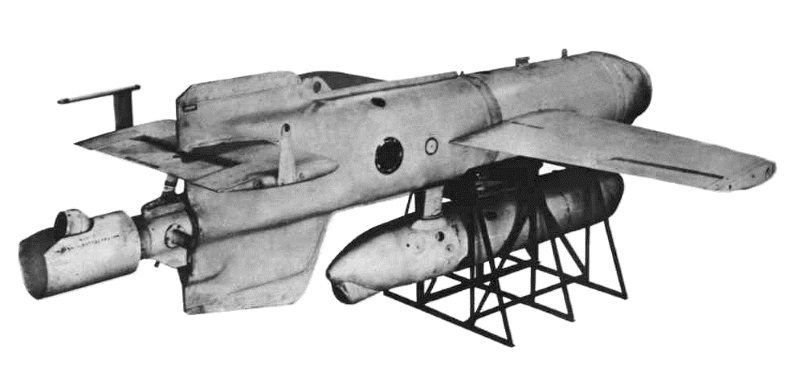
The Walter rocket was powered by a fuel known as "Z-stoff", which was a water-based solution of sodium permanganate or calcium permanganate, and an oxidizer known as "T-stoff", or concentrated hydrogen peroxide -- a fluid that is, incidentally, unstable, corrosive, and in general extremely nasty to handle. The Z-stoff was actually a catalyst that promoted the breakdown of the hydrogen peroxide into steam. The rocket motor could provide 5.9 kN (600 kg / 1,320 lb) of thrust for ten seconds. A flare was fitted to the tail of the Hs 293A to allow the operator to track its flight, after tests demonstrated it was hard to see the weapon at long range under conditions of poor visibility.
The warhead was based on the standard 500-kilogram (1,100-pound) SC 500 high explosive bomb. The SC 500 was not an armor-piercing bomb; the Hs 293A was intended for attacks on merchant vessels and other unarmored ships. The forward part of the Hs 293A's fuselage consisted of the warhead, while the rear part contained the control electronics and batteries. The fuselage was 3.82 meters (12 feet 6 inches) long, and the entire weapon weighed 1,045 kilograms (2,300 pounds).
The production Hs 293A was controlled by the "Kehl-Strassburg" superheterodyne radio command and control system, with the Kehl transmitter unit in the launch aircraft and the Strassburg receiver system in the glide bomb. The bomb could be preset to one of 18 different frequencies in the 48:50 MHz band to allow up to 18 bombers to each drop and control a glide bomb simultaneously. The operator guided the bomb with a joystick wired to the Kehl transmitter. The first aircraft fitted to carry the Hs 293A was the Dornier Do 217. Eventually, the weapon was also carried by the Heinkel He 177, the Focke-Wulf Fw 200, and (in a pinch) by other types.
In operation, the carrier aircraft generally carried two Hs 293As, one under each wing. Engine exhaust was piped into the bombs to keep the propellants from freezing. On release, the flare in the tail of the bomb and the booster rocket were ignited. The operator tracked the bomb by watching the tail flare, and used the Kehl unit's joystick to keep the bomb lined up on the target. Depending on glide angle, the bomb could reach terminal velocities of 435 to 900 KPH (270 to 560 MPH). With release from an altitude of 1 kilometer (3,280 feet), the Hs 293A could glide as far as 11 kilometers (6.8 miles).
* Work on the Fritz X proceeded in parallel with work on the Hs 293. Fritz X was also known as the "FX 1400" or "X 1" by the manufacturer, Ruhrstahl AG, and "PC 1400X" by the German Air Ministry (Reichsluftfahrtministerium / RLM). The Fritz X was designed by a team under Dr. Max Kramer of the German Aviation Research Institute (Deutsche Versuchsansalt fuer Luftfahrt / DVL), beginning in 1939. Like the Hs 293A, the Fritz X did not reach operational status until the summer of 1943.
The Fritz X had some technology in common with the Hs 293, but it had a very different configuration. The Fritz X was based on the 1,400-kilogram (3,090-pound) PC 1400 hardened armor-piercing bomb. The Fritx X was 3.26 meters (10 feet 8 inches) long and weighed 1,570 kilograms (3,461 pounds). There were four stubby fixed wings arranged in a cruciform pattern around the bomb's center of gravity, giving it a wingspan of 1.35 meters (4 feet 5 inches). The Fritz X had a steeper glide angle, and so shorter range, than the Hs 293A.
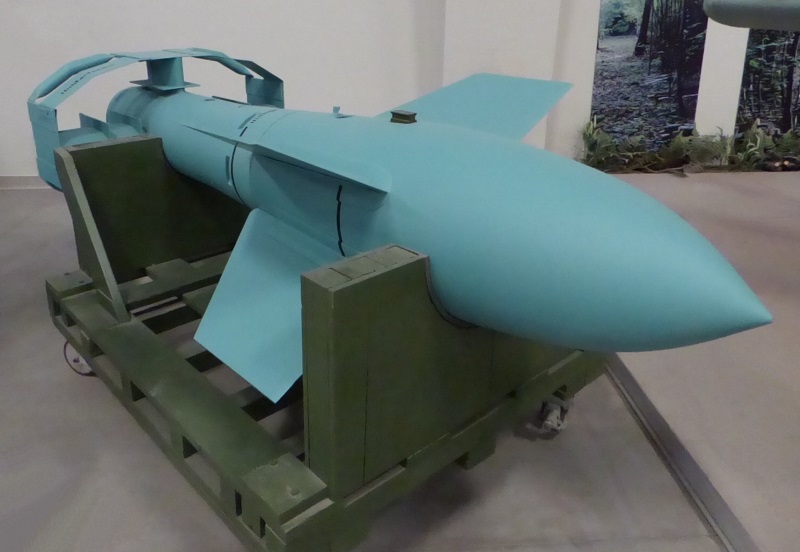
The box-shaped 12-sided tail framed vertical and horizontal fins. The fins had spoilers mounted on them to provide aerodynamic control, with the fins actuated by solenoids to pop them in and out of the airstream at a rate of ten times per second. The bomb was directed by a Kehl-Strassburg system like that used with the Hs 293A, and also had a internal gyro system to keep it from rolling. The Fritz X did not have a boost motor, but a tracking flare was fitted in the tail.
The Fritz X was carried by Dornier Do 217 and Heinkel He 177 bombers. A Do 217 could only carry one Fritz X, in contrast to two Hs 293As. A total of about 2,000 Fritz X bombs was built, with 200 used in combat. Further work focused on development of a wire-guided version and then a spin-stabilized version, but these efforts were canceled, since increasing Allied pressure on Germany meant that more emphasis had to be placed on defensive rather than offensive weapons.
BACK_TO_TOP* Luftwaffe aircraft armed with glide bombs went into combat at the end of August 1943, attacking Allied shipping in the Bay of Biscay. On 25 August 1943, they sank the escort sloop HMS EGRET and badly damaged the destroyer HMCS ATHABASCAN. These attacks were among the first recorded instances of operational use of guided weapons. The British Admiralty ordered their warships to stay at least 320 kilometers (200 miles) from the French coast until countermeasures could be devised.
The glide bombs were used more intensively in the Mediterranean, with spectacular results at first. Late on 8 September 1943, the terms of Italy's armistice with the Allies went into effect, and the Italian fleet left their anchorage on the Italian mainland, bound for Malta, where the ships would be surrendered. The Italians told the Germans that the fleet was going to sea to fight the Allies, but the Germans were suspicious, and Luftwaffe aircraft shadowed the warships to see where they were going.
The next day, as the fleet passed through the Straits of Bonafacio, which separates Corsica from Sardinia, it was attacked by 11 Do 217s carrying Fritz X glide bombs. The bombers concentrated their attacks on the large modern battleships ROMA and ITALIA. The ROMA was hit twice, bringing it dead in the water while fires raged below decks. Twenty minutes after the first hit, the fires reached the ROMA's magazines, the resulting explosion breaking the ship in half; it folded up and sank with most of her crew. The ITALIA was hit by a single Fritz X -- but though the battleship took on water, it managed to limp to Malta.
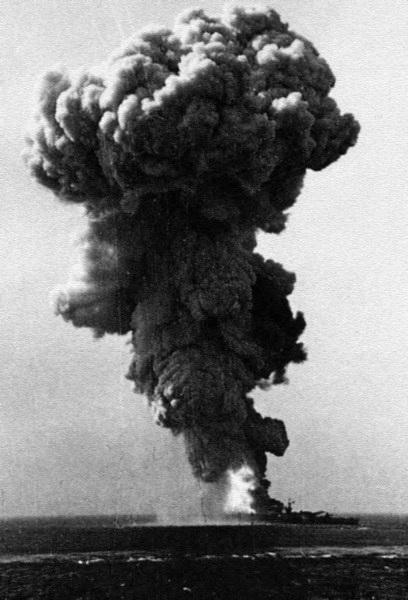
That same day, the Allies landed on the beach at Salerno to begin their movement into Italy. The Luftwaffe responded with a week of glide bomb attacks, badly damaging the battleship HMS WARSPITE, the cruisers HMS UGANDA and the USS SAVANNAH, and sinking or damaging several other lesser vessels. The WARSPITE was hit by three Fritz X bombs, one of which penetrated six decks and blew a hole in the ship's bottom. The ship took on a good deal of water and was completely disabled, but fires didn't break out and casualties were only 9 dead and 14 wounded, blessedly light for such a beating. The battleship was towed away, and did not return to action until June 1944.
The Luftwaffe also mounted a number of raids in October and November 1943 against Allied convoys in the Mediterranean, using Hs 293As to attack escort vessels so the merchantmen could be struck by torpedo-carrying Junkers Ju 88 bombers. However, the days of the Luftwaffe's success with the glide bombs were short-lived. Allied air superiority was steadily growing, and when the Allies landed at Anzio in January 1944, German bombers encountered fierce fighter opposition and suffered badly, though they did sink the cruiser HMS SPARTAN.
In addition, the Allies introduced electronic countermeasures against the Kehl-Strassburg control system. One system was a broadband jamming transmitter that simply disrupted the control transmission with radio noise. Another system was subtler, "spoofing" the bomb by sending false control signals to the Strassburg controller that slammed the weapon's control surfaces to an extreme position, causing it to stall and tumble, or descend in an aimless spiral. When the Luftwaffe attempted to attack the Allied fleet during the Normandy landings in June 1944, they were unable to overcome Allied fighter defenses. What few glide bombs they dropped were ineffective due to jamming and spoofing. The Hs 293A and Fritz X were no longer useful weapons.
* Research was conducted at Henschel to the end of the war on more advanced variants of the Hs 293 in hopes of improving the weapon's combat effectiveness. The "Hs 293A-2" was a production change on the A-1 variant, involving a spoiler control system, and the A-2 was used in action.
The success of the Allies in jamming the Kehl-Strassburg system led to the "Hs 293B", which featured the "Dortmund-Duisburg" wire guidance system. The Hs 293B had a range of 30 kilometers (19 miles), with wire spooling out from both the bomb and the launch aircraft. 200 Hs 293Bs were rebuilt from Hs 293A production, and were used in limited numbers in the Mediterranean by bombers flying from northern Italy at the end of the war.
Hitler had ordered that the glide bombs not be used against land targets, in fear that the Allies might be able to recover a dud and learn the secrets of the technology. With the Allies closing in, the order was lifted, and in April 1945, Hs 293Bs were used on attacks on bridges over the river Oder in vain hopes of slowing down the Soviet advance on Berlin.
The Hs 293 was a reliable and mature weapon, so it was used as the basis for a wide range of other weapon concepts, none of which saw operation, and many of which were never more than paper projects:
Other versions studied included delta-winged weapons; a missile intended to blast apart enemy bomber formations; and next-generation supersonic missiles. These weapons were more or less "paper projects".
BACK_TO_TOP* The technology to develop guided weapons was easily available to most of the combatants during World War II, but the Americans lagged the Germans, mostly because of official indifference. The US Army Air Forces (USAAF) developed three series of glide weapons:
Little information can be found on the BG weapons. The only one of the series that actually flew was the "XBG-1", which was a conversion of a Fletcher PQ-11A target drone, which itself did not reach production. The drone's engine was replaced by a 900-kilogram (2,000-pound) bomb. The glider was to be towed to the target area and released, to be guided into the target by a TV seeker. Ten XBG-1s were built, but that was the end of it. The proposed Fletcher "BG-2" and "BG-3" glider bombs didn't even reach the prototype stage.
The GB series were winged bombs more along the lines of the Hs 293A. They were the result of a series of studies into guided weapons performed in the US in 1940 and 1941. Most of these studies went nowhere because of disinterest, or because the organizations involved knew either about aircraft or about electronics -- but not both.
The Aeronca "GB-1" project survived because of its simplicity, though "crudity" might be a better word. The GB-1 was a 900-kilogram (2,000-pound) bomb fitted with wooden wings spanning 3.66 meters (12 feet), and a twin-fin tail assembly carried on twin booms, giving it a length about as long as the wingspan. The weapon's appearance was definitely unsophisticated. The GB-1 was guided by a gyroscopic stabilization system. It was aimed by a bombardier from a distance in front of the target, and after release the bomb simply glided away in that direction.
The rationale for the GB-1 was not stand-off distance. The concept was that a glide bomb falling at a shallow angle into a target area had a high probability of hitting the side of a tall and presumably valuable structure, while ordinary bombs falling straight down hit almost anywhere within the target area. Although in hindsight the concept seems dubious, USAAF commander General Henry H. "Hap" Arnold was in a hurry, and a gyrostabilized bomb could be developed more quickly than a radio-controlled weapon.
The GB-1 was actually issued to the USAAF 8th Air Force in late 1943, with the weapons mounted in pairs on Boeing B-17 Flying Fortress bombers, with one bomb on shackles beneath each wing. They were used in some quantity in bombing attacks on Cologne, Germany, in early 1944. Results were unsurprisingly dismal. Accuracy was poor, while a B-17 with an external bombload suffered greatly in terms of handling, range, and performance. Although about a thousand GB-1s were used in combat, the weapon was abandoned.
* The Bellanca "GB-2" and Timm "GB-3" were similar 900-kilogram (2,000-pound) weapons, which were dropped at an early stage in favor of the GB-1. The GB-1 was followed by a series of variants, all built by Aeronca, of similar configuration but with different seekers and so on:
These munitions never got out of the test stage and were canceled at the end of the war, or shortly after. A "Glide Torpedo" weapon designated the "GT-1" was developed. It was basically along the same lines as the German glide torpedoes, being essentially a GB-1 with the bomb replaced by a Mark 13 air-dropped torpedo. The GT-1 trailed a small kite assembly and released the torpedo when the assembly hit the water. The GT-1 was actually used in the Pacific Theater late in the war, being delivered by North American B-25 Mitchell bombers. They proved effective, allowing the torpedoes to be delivered from maximum range; the only problem was assessing target damage. Further use was curtailed by the end of the conflict.
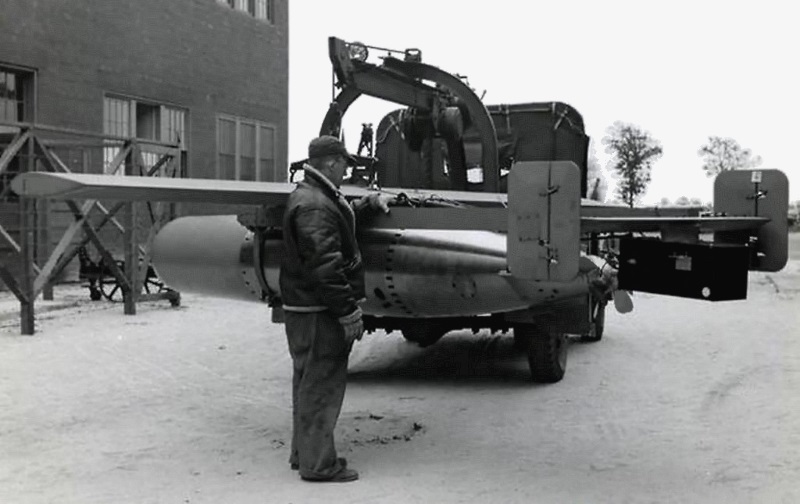
The TV-guided "GB-4", developed directly by the USAAF, was a more refined weapon than the GB-1, with a similar configuration but cleaner implementation. It was actually used in combat, but though it had performed well in tests, for various reasons it did badly in the field. One of the problems seems to have been the poor quality of the image returned by early TV camera tubes, which restricted operations to broad daylight, fair weather, and easily distinguished targets. Reliability of the electronics was apparently another troublesome issue. A pulsejet-powered variant, the "JB-4", was developed but never got out of the test stage.
As with the GB-1, a number of variants of the GB-4 were developed:
As with the GB-1 variants, none of these weapons got out of the test stage, and were all canceled at the end of the war, or shortly afterward. A "GB-10", which was a GB-1 with a GB-4 guidance system, was considered but not built.
BACK_TO_TOP* The VB series munitions were in general more conceptually similar to the German Fritz X weapon, consisting of finned bombs, and were more successful than the GB munitions. All the VB weapons were developed by the USAAF Air Materiel Command at Wright Field, Ohio.
The first eight weapons in the series, "VB-1" through "VB-8", were modified standard aerial bombs. The VB-1 was based on the standard M44 450-kilogram (1,000-pound) high explosive bomb. It was fitted with a new tail featuring a gyrostabilization system, a pair of rudders, and a tracking flare. This weapon could only be steered right and left, and so it was named "AZON", for "azimuth only". The later "VB-2" was a 900-kilogram (2,000-pound) bomb with the same guidance scheme, though apparently it was not built in large numbers. A radio control system conceptually similar to the German Kehl-Strassburg system allowed a bombardier to direct the bomb with a joystick. This radio control system had five channels, allowing five bombers to drop and control an AZON simultaneously.
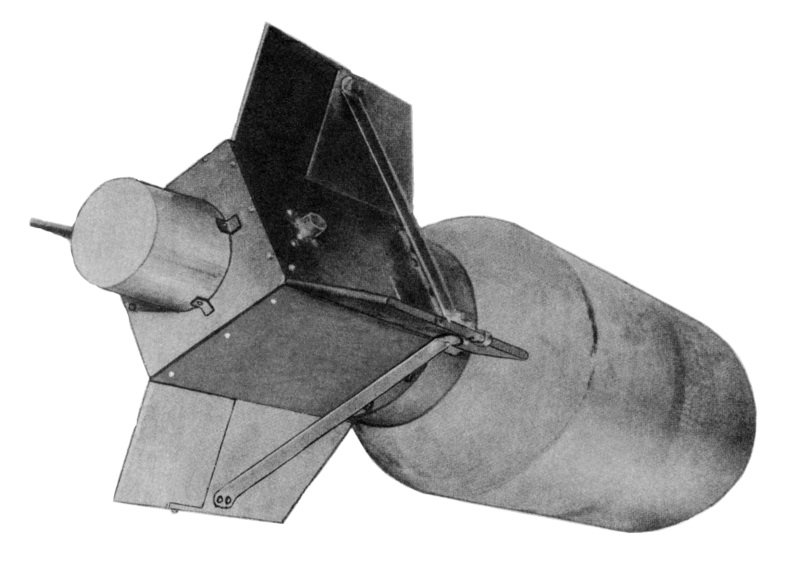
Design work on the VB-1 began in the summer of 1942, but the weapon's gyrostabilization system proved ineffective, and in early tests the AZON showed a tendency to roll, making its control surfaces useless. Eventually the bugs were worked out, and test drops showed the guided bomb had between one and two orders of magnitude more accuracy in hitting targets than an unguided bomb.
These successful tests convinced USAAF officers of the merits of guided bombs. There had been considerable resistance to the idea because the AZON wasn't a "fire and forget" weapon: once dropped, the launch aircraft had to remain on course while the operator guided the bomb into the target. Since this remained a problem through the following history of air-launched guided weapons, it was not an unreasonable concern. Those who accepted the usefulness of guided glide bombs, on the other hand, found the restriction to "azimuth only" guidance too severe, and wanted to wait until a fully-guided next generation weapon was available. However, the test results, and the effective use of the Hs 293A and Fritx X on the Allies in the late summer of 1943, decided the issue.
A total of 15,000 AZONs was built through 1944. The AZON was fielded in early 1944 in Europe, and was used operationally in attacks on targets in northern Italy. Since AZON, as its name implied, could be steered side to side but not up and down, it was suited to attacking long, narrow targets like bridges and viaducts. Results were unimpressive. First, AZON was difficult to use. Its effectiveness depended greatly on the training and skill of the operator in guiding a bright point of light to a target kilometers away.
Second, one bomber would drop multiple AZONs on a target, with the bombardier directing the first and hoping the others would follow. However, aerodynamic imbalances in individual bombs ended up dispersing the bomb pattern widely over the target. In fact, the dispersal was in general greater than it would be for unguided bombs; unguided bombs rolled on the way down, reducing the effect of aerodynamic imbalances, while AZON was specifically designed not to roll, allowing imbalances to build up.
Weapons developers at first experimented with linking all the AZONs in a bombload together with a cable. This caused a whipsaw interaction among the bombs while they fell that made the bombs completely unguidable, and generally snapped the cable. The engineers then tried a nylon rope, whose "rubber band" action made the interaction between the falling bombs even more interesting. They finally gave up and decided that only one AZON would be dropped by one bomber in each pass on a target -- meaning only five AZONs could be used at a time, which was less than optimal for attacks on tough targets.
AZON went into action against the Japanese in Burma in late 1944. Allied sea control was so tight that the Japanese could no longer send supplies to Burma by ship, and so supplies were sent by train from southern China instead. The northern Burmese terrain is very rugged, the rail routes required many bridges, and so these bridges very high priority targets for the USAAF. The Japanese understood this perfectly, and set up heavy anti-aircraft defenses to protect the bridges. That meant that USAAF heavy bombers had to bomb a target that was difficult to hit, while dodging Japanese antiaircraft fire.
AZON seemed like a good solution, and a total of 459 of them were dropped, destroying 27 bridges. The fact that a bomber had to stay on course in the face of flak while its bombardier guided the AZON into a bridge was a dangerous nuisance, but the USAAF came up with a clever solution.
Bombers were often escorted by Lockheed P-38 Lightning fighters flying "top cover" over the bomber formation to provide protection against enemy fighters. The higher altitude of the fighters gave them some protection against flak, and the Japanese concentrated their fire on the bombers anyway, since they were the greater threat. A number of P-38s had been modified with clear "droop snoot" bomber noses to accommodate a bombardier, with these aircraft operating as "leads" for a flight of conventional P-38s carrying bombs and targeting for them; when the lead dropped its bombs, all the other Lightnings did as well. Some of the "droop snoot" P-38s were fitted with an AZON controller. A bomber would drop an AZON and then take evasive action, while the bombardier on board the droop-snoot P-38 would guide the AZON into the bridge. This scheme would be known in a later time as "buddy designating".
* The attacks on Burmese bridges showed that radio-guided guided munitions had some potential, and advocates hoped that the next series of fully guided bombs would be even more effective. This series consisted of the fully guided "VB-3" (450-kilogram / 1,000-pound) and "VB-4" (900-kilogram / 2,000-pound) "RAZON (Range And Azimuth Only)" guided bombs, characterized by a double box tail. About 3,000 were built, but the weapon did not reach operational status during World War II.
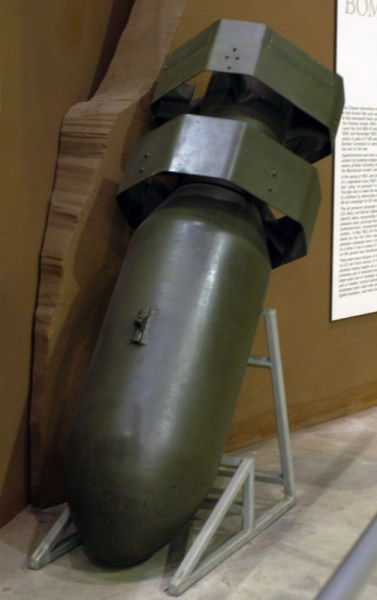
The USAAF experimented with other VB weapons that never got out of the test phase:
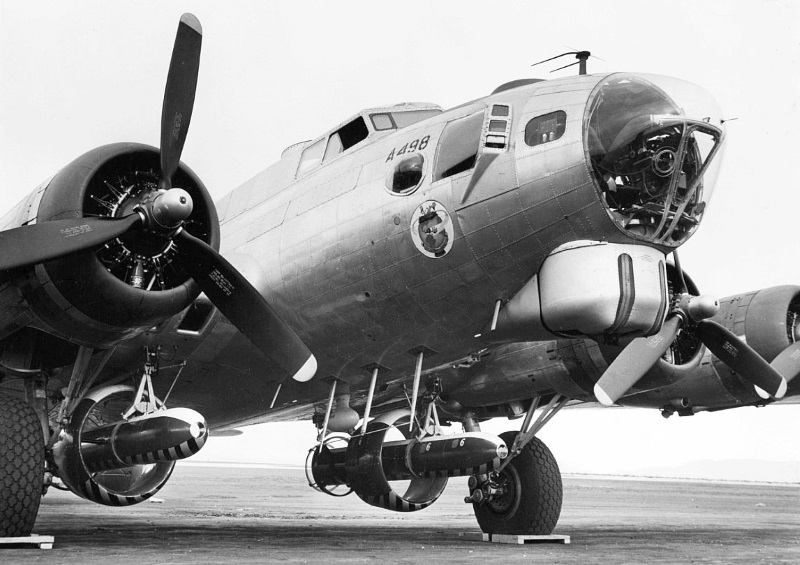
The "VB-13", known as "TARZON" and later redesignated "ASM-A-1", was the only one of these later VB weapons to actually see action. It was a monster, a derivative of the British Tallboy deep-penetration bomb weighing 5.44 tonnes (12,000 pounds) and 6.4 meters (21 feet) long. It had a circular forward wing and a box tail, with four rudders on fins within the tail. It was, like the German glide bombs, radio-controlled and had a flare on its tail for optical tracking.
Interest in such guided weapons declined in the years immediately after World War II. The electronics technology available was simply not reliable enough for combat use, and the experimental seeker systems suffered from low sensitivity and contrast. Despite these limitations, research continued at a low level, and in 1950, just before the beginning of the Korean War, the USAF began a RAZON field test program with the 19th Bombardment Group, which flew Boeing B-29 Superfortresses from Okinawa. However, various glitches prevented any RAZON drops until August 1950, when the war was in full burn.
The initial RAZON combat tests were a fiasco, due to reliability problems, poor crew training, and lack of proper equipment. The problems were finally under some degree of control by the end of September, and then the 9th flew a series of "bridge busting" raids against North Korea using RAZON. A single B-29 carried eight RAZONs. Many of the bombs were defective; of a total of 489 RAZONs dropped in Korea, only 331 worked. However, accuracy of the bombs that worked was very good, and with experience, the bomber crews made better use of them. By the time RAZON drops ended in December 1950, they had destroyed 15 bridges.
The raids were helped by the fact that a 47-channel radio controller had been developed for RAZON, allowing up to 47 bombs to be guided at one time. However, the VB-3 was really too small to easily destroy a bridge. On the average, it took four direct hits from a 450-kilogram (1,000-pound) bomb to do the job.
The huge TARZON didn't have that problem, and TARZONs were sent to Okinawa in December 1950. They were so big that they could not be carried inside a B-29, having to be strapped to the belly of the aircraft. Records of the TARZON attacks are contradictory, but it appears that 30 were dropped, with six of them scoring direct hits on bridges and clearly destroying the targets. Unfortunately, there were other problems with the TARZON. Hauling around such a huge weapon was troublesome, and one B-29 carrying a TARZON disappeared over the ocean with its crew. Nobody knew what happened, but there were suspicions that the crew had tried to dump the bomb at low altitude in an emergency, with the bomber going up with it; or even that the TARZON had spontaneously exploded. TARZON missions were halted in August 1951.
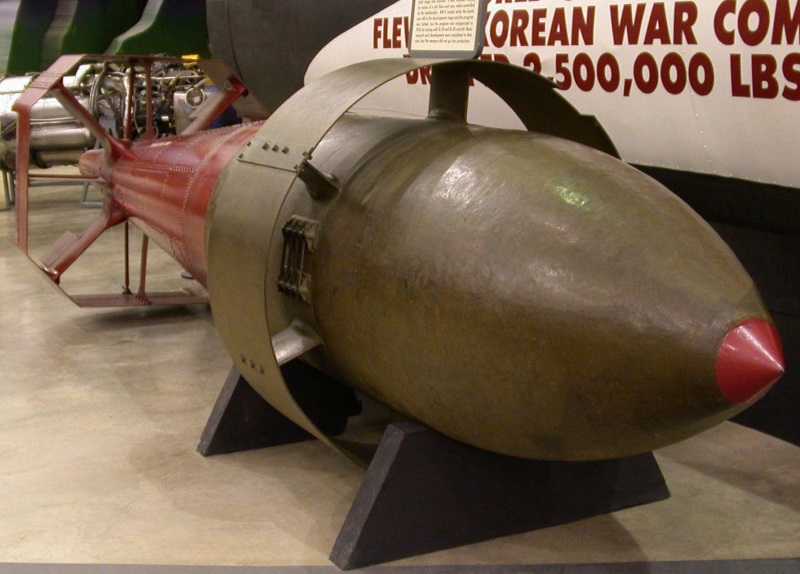
Despite the problems, the overall results were encouraging. However, in the immediate post-Korean war timeframe, the US was desperately working on the nuclear option to keep ahead of the Soviets, and there were no resources available to work on tactical guided munitions. The technology generally went on the fade until the mid-1960s. Surplus TARZONs were said to have been used as unguided munitions during the Vietnam War in "Commando Vault" operations to clear helicopter landing zones in the jungle. They were rolled out of the back of Lockheed C-130 transports and descended on parachutes.
The US glide bombs also led, if not directly, to the "AGM-12 Bullpup" air-to-surface missile series, designed in the 1950s fielded through the 1960s and into the 1970s. It was a solid-fuel missile, its guidance being much like that of the glide bombs -- the pilot steering it by radio control, watching a flare on the rear of the missile. Although it was used to a limited extent in the Vietnam War, it did not work well, simply proving a stepping stone to a new generation of guided air-to-surface weapons that were far more effective.
BACK_TO_TOP* The US Navy's (USN) experiments with glide weapons were even more obscure than those of the USAAF's, with one prominent exception.
The Navy experimented with "Bomb Gliders" of their own, which like the USAAF's weapons, appear to have been unpowered drones; as well as an infrared heat-seeking guided bomb named "Dove" that seems to have been similar to the USAAF's VB series. Details of these weapons are unclear.
The Navy also worked on a rocket-boosted glide weapon named the "Gargoyle", with the initial designation of "LBD-1", later changed to "KSD-1". The Gargoyle was conceptually similar to the Hs 293, and in fact may have been inspired by it. McDonnell was awarded a contract for five Gargoyle prototypes and 395 production missiles in September 1944. The Gargoyle carried a 450-kilogram (1,000-pound) armor-piercing bomb, built into a smoothly curved airframe with low-mounted rounded-tip wings and a vee tail. Length was 3 meters (9 feet 10 inches), wingspan was 2.6 meters (8 feet 6 inches), and total weight was 748 kilograms (1,650 pounds).
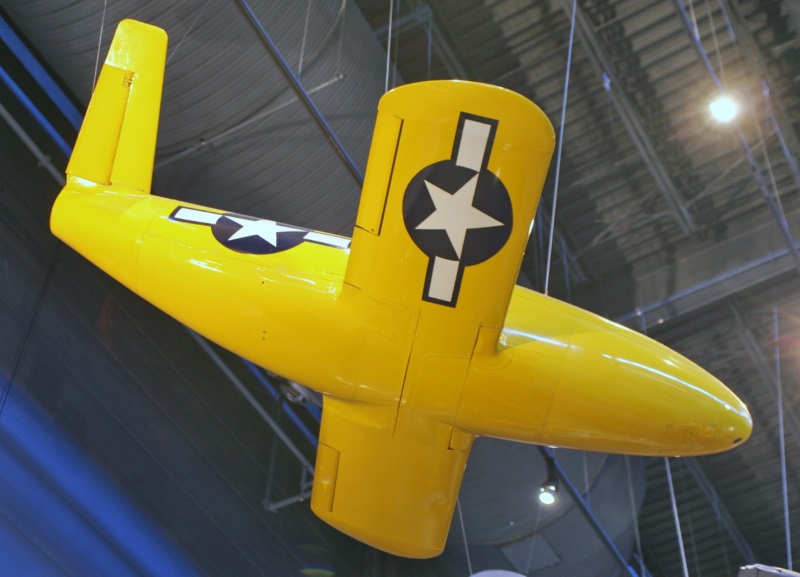
The Gargoyle was intended for launch by carrier-based strike aircraft, though apparently it was also considered for surface launch by rocket booster or catapult system. The missile had a solid rocket unit built into the tail to give it a launch boost, and was guided visually by an operator using a joystick connected to a radio link. As with the Hs 293, the Gargoyle had flares in its tail to allow the operator to track it.
Fourteen flight tests were conducted from October 1944 through July 1945. The end of the war robbed the program of momentum, though test flights continued into 1947. The weapon was redesignated "RTV-2" in that year and then "RTV-N-2" in 1948, but by that time the effort was almost completely dead. There was some consideration after that of using the Gargoyle airframes as targets, but the program was formally axed in 1950.
* The prominent exception was the Naval Bureau of Ordnance's "Bat" anti-shipping weapon, which was fielded operationally, and was one of the most impressive guided weapons developed during World War II. Design work that led to the Bat began in 1941 and evolved through various forms.
The original concept was named "Dragon", given as the "Dryden Bomb" in some sources; one of the lead researchers on the project was Hugh L. Dryden of the National Bureau of Standards (NBS), who would later become one of the founding senior officials of the US National Aeronautics & Space Administration (NASA). Dragon was defined as a radio-controlled glide bomb with a 900-kilogram (2,000-pound) warhead, with a plywood airframe designed by the NBS. A few were tested in 1942, but the Navy wasn't enthusiastic about the idea of the launch aircraft being forced to stick around up to weapon impact, and quickly gave up on the concept. A TV-guided variant named "Robin" was then tested, but TV was simply not ready for combat at the time.
The research effort then moved on to the "Pelican" or "Special Weapons Ordnance Device (SWOD) Mark 7", which was intended for anti-submarine warfare. It carried a depth charge for attacks on surfaced U-boats, and was fitted with a "semi-active radar homing (SARH)" seeker that homed in on reflections from a radar beam emitted by the launch aircraft. Use of a depth charge set to go off at shallow depth provided a higher "kill probability" against a submarine than a straight high-explosive warhead.
Hitler's U-boats were decisively defeated in the spring of 1943, and the Pelican itself did not go into production. The Navy had built a fair stock of the Pelicans, however, and didn't want them to go to waste. Some were given sand-filled "warheads" and used as "Vulture" targets to train warship anti-aircraft gunners; others were fitted with a passive radar homing seeker and renamed "Moth", though they were never used operationally.
The only one of the SWOD series to reach production was the "SWOD Mark 9", the Bat. It was built around a 450-kilogram (1,000-pound) bomb, and had an active radar seeker. Its NBS-designed airframe had a high wing and twin tailfins. The Bat was 3.63 meters (11 feet 11 inches) long, had a span of 3.05 meters (10 feet), and weighed 853 kilograms (1,880 pounds).
Incidentally, some Pelicans were converted to a "Poor Man's Bat" configuration by the simple measure of adding a radar transmitter to complement the Pelican's SARH seeker. These weapons may have been used for trials, though some sources say there was a push to introduce them to combat on a fast-track basis; in any case, the Navy preferred to go on to the definitive Bat.
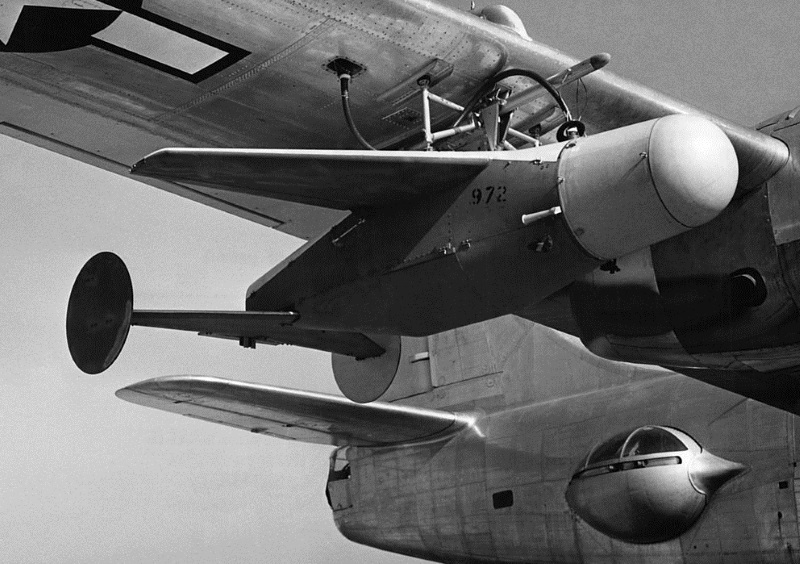
The Bat's guidance system was particularly sophisticated for the time. After being dropped, it glided toward the target on a preset course using a gyrostabilizer system to keep it on track. As it neared the target, the bomb locked on with its own radar system to perform its terminal attack. Since the radar seeker was conceptually similar to the "sonar" system used by a bat to prey on flying insects, the weapon was named after the bat. The Bat also included a self-destruct mechanism to keep it from falling into enemy hands, and obtained its electrical power from four small windmill generators.
The Bat was put into operation in May 1945, on Navy PB4Y-2 Privateer patrol bombers, maritime derivatives of the Consolidated B-24 Liberator. One Bat was carried under each wing. Privateer crews claimed many successes against Japanese shipping in the seas around Borneo, though some sources suggest they may have exaggerated the weapon's effectiveness. Bats with modified guidance systems were also used against ground targets in Burma and other Japanese-held areas; they simply homed in on the biggest target in their radar seeker.
The Navy tinkered with the Bat for a time after the war, successively renaming it "ASM-2" and then "ASM-N-2". However, its radar seeker was too easily spoofed, and the weapon quickly faded into obscurity.
BACK_TO_TOP* In one of the more eccentric stories of World War II, the US military backed an investigation into weapons guided by trained pigeons. The investigation was conducted by the well-known behavioral psychologist Burrhus Frederic Skinner.
In early 1942, Skinner, then of the University of Minnesota, conducted preliminary studies on the concept of using trained animals as a guidance system. The studies were funded at a low level by General Mills, a major food producer. The US National Defense Research Committee (NDRC) -- which funded new technologies that might be useful for winning the war -- was skeptical of the idea, but in mid-1943 awarded a $25,000 USD contract to General Mills to continue the work. The investigation was codenamed Project PIGEON (AKA ORCON for "Organic Control"), and Skinner hoped to be able to use pigeons to guide a weapon to within 6 meters (20 feet) of a target.
Three pigeons were each tucked into a jacket made of a sock, and then put into a harness inside the guidance system, facing a screen. An image of the target was projected onto each of the three screens through a lens system in the nose of the weapon, with crosshairs defined by beams of light. Each pigeon was supposed to peck at its screen, which was wired to provide feedback to the missile's flight controls, to keep the crosshairs on target. The system accepted inputs from all three pigeons, but only acted if two or all three agreed. The pigeons were trained with slides of aerial photographs of the target, and if they kept the crosshairs on the target, they were rewarded by a grain deposited in a tray in front of them. Skinner later found that the pigeons were less easily disturbed under confusing circumstances if they were fed hemp (marijuana) seeds rather than grains.
Skinner hoped to fit the pigeon guidance system to a Pelican, but he never managed to overcome official skepticism. When he put on a demonstration in New Jersey of the pigeon guidance system for officials of the US Office of Scientific Research and Development (OSRD), he was bitterly frustrated to see they were amused instead of impressed.
Project PIGEON was abandoned. Skinner went home with 24 trained pigeons, which he kept in a dovecote in his garden. Whether the idea was practical or not, it appears that Skinner as a academic psychologist simply was not on the same wavelength as the industrial engineers and military officials he was trying to work with, and never managed to communicate with them effectively.
BACK_TO_TOP* Only the Germans and the Americans appear to have used glide weapons in combat during World War II. The British seemed content to let the Americans, who had greater resources, tinker with them. The Japanese Army did work on a series of air-to-surface guided weapons designated "I-GO-1", but never used any of them operationally. The one Japanese guided air-to-surface weapon that was fielded was the notorious piloted "Oka (Cherry Blossom)" bomb, which was carried by a bomber and used three solid rocket boosters to accelerate it towards its target. It proved unsuccessful, mostly due to the vulnerability of the launch aircraft, and ended up being little more than a testament to Japanese desperation as defeat loomed.
A Soviet designer named Vladimir Vakhmistrov -- an ingenious fellow, best known for his work on using bombers as "flying aircraft carriers" for fighters -- came up with an interesting paper design for a glider bomb in 1944. This scheme involved a twin-boom glider, with each boom tipped by a 1,000-kilogram (2,200-pound) bomb. A fighter was attached to the top of the glider on struts to provide propulsion and targeting, and the whole system took off on an undercarriage system that was to be dropped after take-off. On release from the fighter, the glider would proceed to target using a gyroscopic autopilot. The scheme was never implemented, which was just as well, experience by other nations in similar schemes proving it wasn't very effective.
The Soviets didn't field guided glide bombs until the mid-1950s, when they introduced two such weapons. The "UB-2F Chaika (Seagull)" was a 2,000-kilogram (4,400-pound) weapon with cruciform delta wings and twin tailfins. An Ilyushin Il-28 Beagle bomber could carry one externally on the centerline; while the Tupolev Tu-16 "Badger" bomber could carry two, one under each wing. A "Tchaika-2" was developed that had a heat-seeker head.
The "UB-5 Kondor" was a 5,000-kilogram (11,000-pound) weapon, and led to an improved "UBV 5" armor piercing variant. Details of the Kondor are unclear, though it likely had a configuration similar to that of the Chaika, and was certainly only carried by the Tu-16. The Chaika and Kondor saw very little service. They were clearly antiquated even when they were introduced, being no great advance over the Hs 293, and the Soviets were moving rapidly to develop much better weapons.
* Sources for this document include:
The website for the USAF Museum at Wright Patterson Air Force Base in Ohio was also useful. When I visited the museum a few years back, I was surprised to find the obscure US glide bombs well represented among the exhibits. Then I learned most of them had been developed there. "Duh."
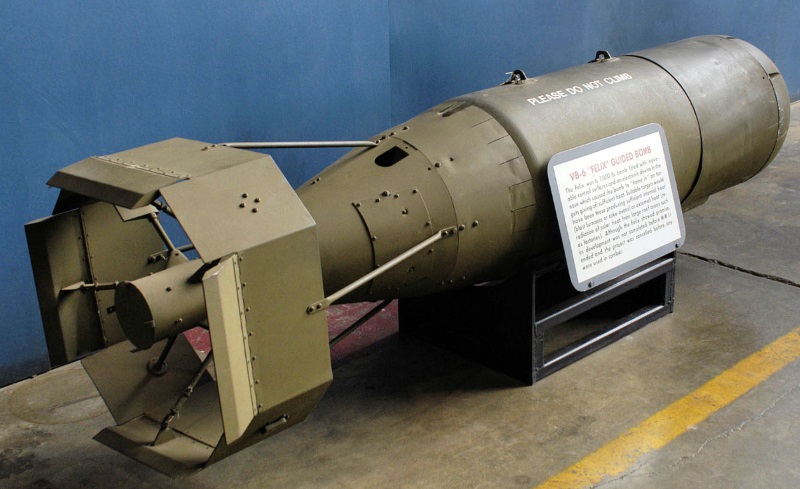
* Illustrations details:
* Revision history:
v1.0.0 / 01 sep 16 v1.0.1 / 01 aug 18 / Review & polish. v1.0.2 / 01 jul 20 / Review & polish. v1.0.3 / 01 mar 22 / Review & polish. v1.0.4 / 01 feb 24 / Review & polish. (+)
This document actually started out in the late 1990s, when I began work on a comprehensive document for guided munitions. It eventually grew very large and unwieldy, proving uneven and hard to maintain, and I finally deleted it in 2014. I then started taking parts of it and reworking them into focused stand-alone documents for the website, and for conversion into ebooks -- one result being this item.
BACK_TO_TOP